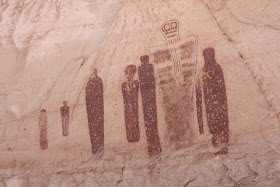Surreal is an overused word, don’t you think? Here are a few synonyms: bizarre, unearthly, dreamlike, phantasmagorical. White Sands National Monument combines all these adjectives while offering visitors an otherworldly sensory experience.
Decades ago I saw a picture of White Sands and I’ve been waiting for a chance to make the trip to Alamogordo, New Mexico ever since. Now here I am on a crisp clear morning, standing among dazzling white dunes.
 |
The brilliant dunes of White Sands, framed by
The San Andres Mountains. |
It’s March and too early for wildflowers but that’s my only regret about being in the dunes today. Even without flowers, photo opportunities present themselves everywhere I look.
And it’s so quiet here. The only noise I hear originates from three jets flying overhead on their way from nearby White Sands Missile Range. But they’re gone in a flash.
 |
The jets are gone and quiet returns to the skies above
White Sands. |
I sip my coffee and munch on a bagel in the deserted picnic area, watching as a family climbs a distant dune, sleds in tow. Sledding the dunes is a popular activity and as I leave the area I notice a partially broken sled lying at the bottom of one of the dunes. Why not? I carry the sled up the hill, sit down, kick up my heels and slide down, sand spraying and hair flying as I go. It’s fun. But once is enough.
 |
| I didn't have to fight for a table at the park's deserted picnic area. |
Next stop: the trailhead for a 5 mile hiking trail. I walk a short way up a hill where 360 degree views await. Two hikers return from the loop trail and it’s only 9:00 a.m. An early start, before the day warms and the winds arrive, is the only way to do this trail.
On top of the hill a woman sits knitting, accompanied by two little dogs.
“It’s a perfect day up here, isn’t it?” she says.
“Yes.”, I agree. “Are you from around here?”
“No, we’re from Michigan—East Lansing”, she points to her husband who is standing atop the rise with a long-lens camera mounted on a tripod.
“What kind of dogs are those?” I ask.
“They’re Morkies, a cross between a Maltese and a Yorkie.”
“They look like they’re enjoying themselves.”
“Oh, they love it out here. This is our first time in the southwest. We started our trip in mid-December and have been traveling all over.”
I’m jealous. Taking a few months to wander the country, stopping wherever the mood strikes and the scenery beckons, it sounds like heaven to this voyager.
By the way, if you’re traveling with dogs New Mexico is an excellent place to vacation. During my journey through the Land of Enchantment I noticed The Albuquerque Zoo, Sandia Peak Tramway and Carlsbad Caverns all providing kennels for your dogs while you enjoy the attractions.
 |
| Mrs. Michigan and her Morkies. |
 |
| These hikers enjoy a quiet morning on the dunes. |
The one mile nature trail is my next destination. The trail is interpretive; signs along the way use an illustrated kit fox to narrate. The fox tells you where she lives, what she eats and how she survives this harsh desert environment. It’s well done—a beautiful short hike.
 |
Vegetation along the nature trail provides hiding places for
meadow voles, lizards, hares and ground-dwelling birds—
all are on the menu of the kit fox. |
****
It’s always fun to learn something new while on vacation, and at the visitor center I do just that. One of the rangers mentions the insect display under glass near the cash register, then points to a large black wasp with orange wings. It’s the Tarantula Hawk, a type of spider wasp, and it delivers the most painful sting of any insect in North America. If you see this scary Halloween-colored wasp stay out of its way or point it in the direction of the nearest tarantula, its preferred victim.
When the wasp finds a tarantula she stings and paralyzes it, then lays her eggs on the unlucky arachnid’s body. After the eggs hatch, the baby wasps have a fat, juicy tarantula to nourish them. Luckily not too many locales host the Tarantula Hawk—look around your neighborhood and if you don’t see any tarantulas then you needn’t fear a bite from this frightening parasitic pest.
 |
You really don't want to be this close to a Tarantula Hawk.
I hope this one was already dead.
(Photo taken from an internet Images site.) |
So, was White Sands National Monument worth the wait? Absolutely. Visit White Sands yourself for a satisfying—dare I say surreal?—experience. Find out more: http://www.nps.gov/whsa/index.htm
Postscript: In 2019 White Sands was "promoted" from a National Monument to a National Park. National Park status is good, yes. But... I fear that the previously lightly visited monument may now become another overrun park. I hope not.
Next week we’ll visit another New Mexico gem: Carlsbad Caverns.




























